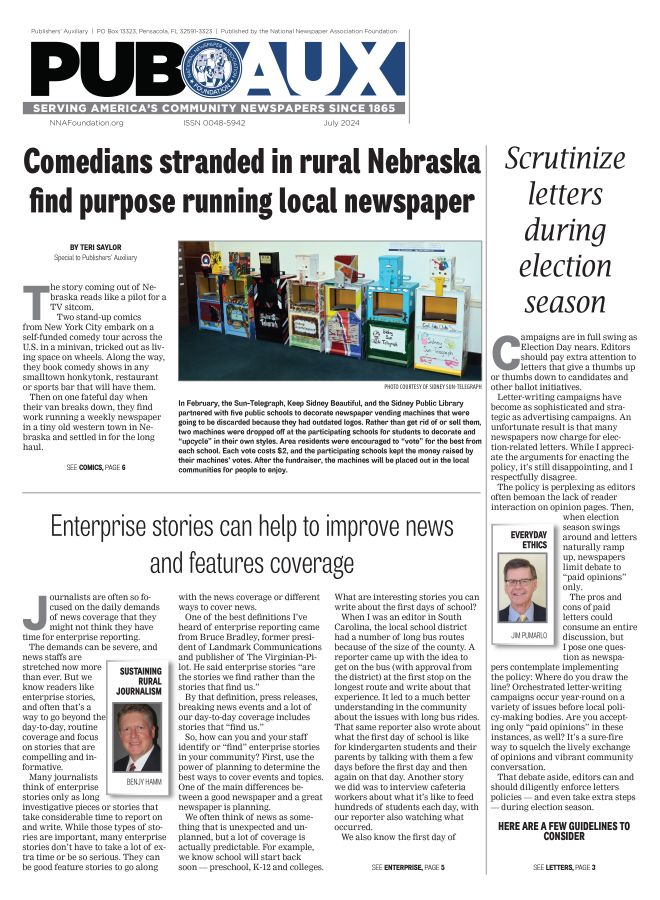Documentary on NM weekly shows strength of local papers
Dec 10, 2013
By Stanley Schwartz
Managing Editor | Publishers’ Auxiliary
ESPANOLA, NM—It was a simple traffic jam. But why was it at the same time every Wednesday evening—in such a small town? It had Ben Daitz scratching his head.
“At first I thought it was just low-riders cruising slowly through town,” said Daitz, a doctor who ran clinics in northern New Mexico and traveled through Espanola to get back to Albuquerque.
Then he learned street hawkers, selling the local Rio Grande Sun, were causing the backups. Most of the weekly’s circulation comes from single-copy sales, said Managing Editor Bob Trapp. The idea to shoot a documentary came to Daitz after he waited his turn and bought a copy of the paper. He liked what he read, and he thought that if a small community paper could cause such a commotion each week, there had to be a good story behind it.
“I was amazed,” he said. “I had never seen anything like it.”
Trapp’s father and mother, Robert and Ruth Trapp, started the paper in 1956 along with another couple. And over the years the dynamic weekly has gained numerous fans and foes. It is the largest paid weekly in the state.
The fandom is obvious through traffic clogged streets on Wednesdays after the paper comes off the press and goes into the hands of the street distributors who sell them to the readers, eager to see what the paper has covered that week.
The detractors are a little less obvious, unless you happen to stroll through the newspaper’s office. Two long shelves are covered in large and small rocks. All of them, Trapp said during the documentary filming, have come through the office’s windows at one time or another.
Daitz had been helping to film consumer health education videos to educate communities about relative health issues. He said he knew the best way to get out this information to rural populations was through TV.
“And I learned about film making in the process,” he said. A family doctor by profession, Daitz also teaches at the University of New Mexico. He started a clinic in northern New Mexico, where he traveled each week with some of his students. The drive through the mountains put him on the path to Espanola and then the Rio Grande Sun.
Daitz soon moved to the paper’s county and became a Sun subscriber.
“I paid to find out what was going on in this community,” he explained. He didn’t have the funds to get a documentary started, so he put the idea on a back burner. Then he applied to the state and received a grant. That got the ball rolling.
When he first approached Robert Trapp about doing the documentary, Daitz said he was met with disbelief.
“I explained why I was interested” in doing this film, and he said “he’d think about it.” It was a while before Daitz was able to get everything together, but he was able to start filming in 2006 on the paper’s 50th anniversary.
“When I went back he (Trapp) gave me carte blanche,” he added.
During the next six years, Daitz and a small group of committed friends and family traveled to Espanola and filmed the paper’s staff and some of the people they covered.
Daitz had his full time job keeping him busy, he said, so he filmed when he could. In 2012, he had shot more than 1,000 hours of film. He was out of money and tired.
“I couldn’t ask people to volunteer any more. I just wanted to finish it,” he said. Daitz knew he had enough footage to put together an hour-long documentary, so he started editing. In August he debuted the film, “The Sun Never Sets,” at the Newseum in Washington. Then it was shown at a few newspaper association conferences and at some journalism schools as well as the PBS affiliate in Albuquerque.
Bob Trapp said Daitz and his volunteers were not intrusive in their coverage of his staff. But not all of his people were happy with the cameras. During the six years it took to shoot the documentary, the paper went through six editors. The one working when Daitz started in 2006 was not on board with the whole documentary idea, Trapp noted, and he did not hide his feelings.
“He’s nowhere in the documentary,” he said.
“They were quite discrete when filming,” especially when the reporters were covering sensitive stories, such as illegal drug activity. The Espanola Valley has the country’s highest heroin overdose rate.
Trapp noted that Daitz interviewed him numerous times, and after an hour or two of questions “he gets to what he really wants to know.” It took about six months before the staff stopped paying attention to the cameras. “It was like he wasn’t there.”
Trapp said he thought Daitz did a good job showing what he and his staff did at the paper on the news side. “But he didn’t capture everything we do,” he added. The investigative news the paper prints is only one part of the overall operation.
“He did not cover the community work we do,” Trapp said. “But that was not what he was after.”
Trapp said his parents started the paper from nothing. They were living in Great Falls, MT, in the mid-50s when they learned Espanola’s business owners were interested in having their own local newspaper. The Trapps, along with Hollie and Bill Birkett met with a dozen business owners. A handshake deal provided the two couples with enough capital to get the paper off the ground.
“They made it clear that these business owners were not investors in the paper,” Trapp said. Eventually, they paid all of them back, and the Trapps bought out the Birkett’s stake in the paper, becoming the sole owners.
The documentary, when shown at colleges and universities, has acted as a recruitment tool, Trapp said.
“I had students coming up to me saying, ‘I want to work for you.’”
But Trapp is skeptical. He believes these young people don’t really know what it takes to do top-notch investigative journalism at a community newspaper. He’d prefer to have them apply for a job after they’ve been in the field for a few years.
Trapp does not have any heirs to take ownership of the paper once he’s ready to retire.
“I don’t like kids,” he said; nor babies or toddlers, and don’t even get him started on teens. To keep the paper local, he created a trust that will take ownership of the paper when he’s gone, so that the Sun truly will not set in Espanola.







